Research - (2022) Volume 10, Issue 6
Correlation of Socioeconomic Status and Dental Caries
Jagadheeswari Ramamoorthy and Mahalakshmi J*
*Correspondence: Mahalakshmi J, Department of Conservative Dentistry and Endodontics, Saveetha Dental College and Hospitals, Saveetha Institute of Medical and Technical Sciences (SIMATS), Saveetha University, Chennai, Tamil Nadu, India, Email:
Abstract
Aim: To study the correlation between socioeconomic status and Dental caries. Background: Dental caries is a global public health problem and influences the overall health of children. The risk factors for caries include biological, socio-behavioural and economic factors. Indicators of socioeconomic status are found to be associated with risk factors for dental caries. Materials and methods: The data of patients visiting OP such as Age, Gender, Caries status and socioeconomic status was collected from DIAS. The data was tabulated in Excel and imported to SPSS version 23.0 for statistical analysis. The statistical tests used were Chi square and correlation analysis. p value < 0.05 was considered statistically significant. Results: Among the low income group, 21.9% had no initial active lesions, 6.63% had initial active lesions only and 5.48% had moderate or extensive lesions. Among the middle income group, 8.93% had no initial active lesions, 39.19% had initial active lesions only and 10.37% had moderate or extensive lesions. Among the high income group, 2.88% had no initial active lesions, 3.46% had initial active lesions only and 1.15% had moderate or extensive lesions. There was no significant association between socioeconomic status and the caries status of the patients Conclusion: Within the limits of the study, we conclude that there was no significant association between socioeconomic status and the caries status of the patients.
Keywords
Caries, Socioeconomic status, Income, Health, Innovative technology
Introduction
Dental caries, periodontal diseases and other diseases related to the oral cavity can affect general health and the quality of life The increasing prevalence of dental caries increases the cost of oral health care and causes a financial burden to families and societies, which are of concern. In recent years, there has been a decline in the prevalence of dental caries in both developed and developing countries. However, the prevalence of dental caries remains high among populations of low socioeconomic background [1]. Indicators of socioeconomic status are found to be associated with risk factors for dental caries. Individuals from low socioeconomic background also experience disadvantages with regard to health in general [1,2]. The association between the different socioeconomic groups and the risk of various systemic health conditions and in access to healthcare services makes social stratification a determinant of these conditions. Advancements in social epidemiology over the past three decades have widened across countries. This poses a challenge to researchers in understanding the social disparities in health thereby improving the health of the overall population [1-3]. However, there is a need to generate improved theoretical frameworks and the necessary data to test and refine them. In recent years, it was also reinforced that socioeconomic status is not only a important predictor of disease occurrence, but the associations reflect causal relations too [4]. Patients from low socioeconomic background with low monthly income and educational level are associated with less access to oral health care services and hygiene products [5,6]. Their knowledge regarding oral health and oral hygiene was also poor, which thereby contributes to a greater frequency and severity of dental caries among people belonging to low socioeconomic status [7,8].
There is also an association between the socioeconomic status of an individual and their oral health. Distribution of carious lesions is also considered to be a good indicator for socioeconomic development in the particular area. Some of the previous studies have shown that people belonging to low socioeconomic status had poorer oral health status when compared to those belonging to high socioeconomic status. This shows that oral health worsens progressively from higher socioeconomic status to lower socioeconomic status. The socioeconomic status of an individual includes their educational background, monthly income and residential area. It is considered as one of the strongest determinants of dental caries in children. Therefore, previous literature suggests that socioeconomic status of the individual is crucial oral health determinants and inequality in socioeconomic status is a major challenge for public oral health.
Our team has extensive knowledge and research experience that has translated into high quality publications [9-28]. The aim of our study is to find the correlation between socioeconomic status and dental caries status among patients.
Materials and Method
This is a Retrospective cross sectional study conducted in a University setting. The study setting had certain advantages like flexibility in data collection and less expenditure. However it had few disadvantages as it is a unicentric study and has geographical limitations. The ethical approval for the current study was obtained from the Institutional Review Board. The data of patients with dental caries were retrieved from the case sheets of patients. The required data from August 2020 to March 2021 were collected and reviewed. The sample size was 347. The inclusion criteria for the study were patients with Dental caries and their socioeconomic status. Exclusion criteria were the incomplete data and were excluded from the study.
The necessary data such as Age, Gender, Caries status and their socioeconomic status were collected and tabulated in Excel. The data was cross verified by the analyzer. The tabulated data from Excel was imported to SPSS version 23.0 for statistical analysis. The data was represented by the means of bar graphs and the statistical tests used were Chi square and correlation analysis. The correlation between Dental caries and socioeconomic status were analysed. Statistical significance was set at p<0.05.
Results
Among the total patients 53.31 % were males and 46.69% were females (Figure 1). 10.37% belonged to the 10-20 years age group, 36.31% belonged to the 20-30 years age group, 23.34% belonged to the 30-40 years age group and 29.97% belonged to the above 40 years age group (Figure 2). 33.72% of patients had no initial active lesions, 49.28% had initial active lesions only and 17% of them had moderate or extensive lesions (Figure 3).34.01% belonged to the low income group, 58.5% belonged to the middle income group and 7.49% belonged to the high income group (Figure 4). Majority of the patients had initial active lesions only. Active caries were found predominantly in the age group of 20- 30 years. Majority of the patients belong to the middle income group. Among the low income group, 21.9% had no initial active lesions, 6.63% had initial active lesions only and 5.48% had moderate or extensive lesions. Among the middle income group, 8.93% had no initial active lesions, 39.19% had initial active lesions only and 10.37% had moderate or extensive lesions. Among the high income group, 2.88% had no initial active lesions, 3.46% had initial active lesions only and 1.15% had moderate or extensive lesions. There was no significant association between socioeconomic status and the caries status of the patients (p>0.05) (Figure 5).
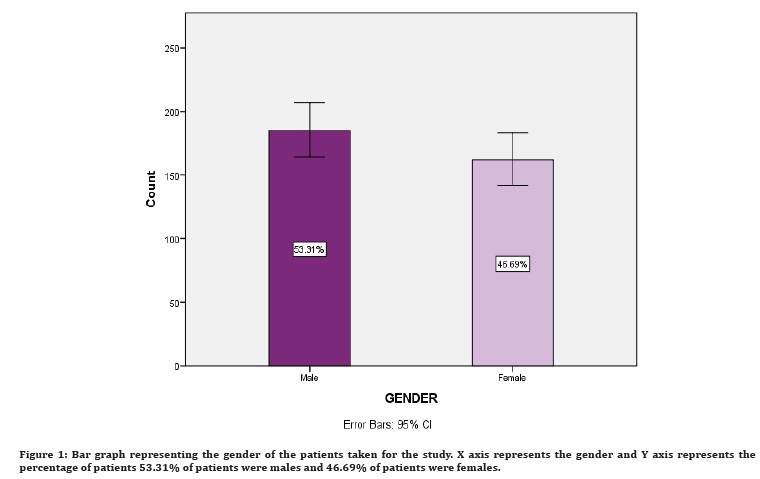
Figure 1: Bar graph representing the gender of the patients taken for the study. X axis represents the gender and Y axis represents the percentage of patients 53.31% of patients were males and 46.69% of patients were females.
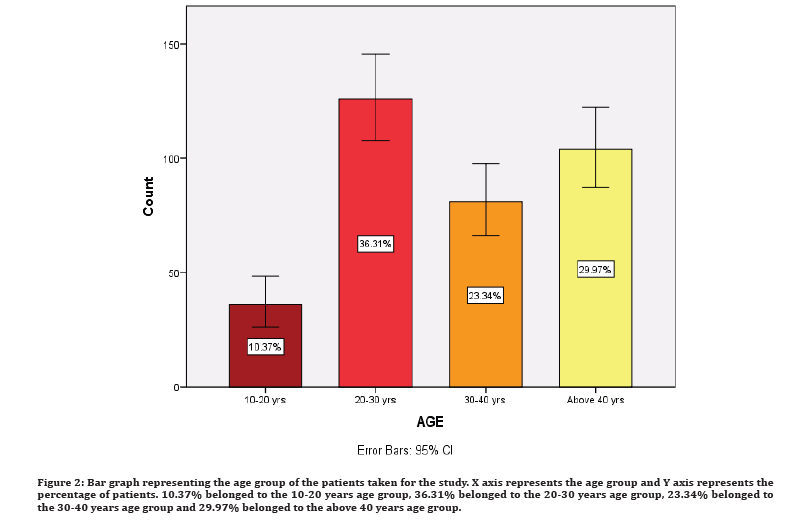
Figure 2: Bar graph representing the age group of the patients taken for the study. X axis represents the age group and Y axis represents the percentage of patients. 10.37% belonged to the 10-20 years age group, 36.31% belonged to the 20-30 years age group, 23.34% belonged to the 30-40 years age group and 29.97% belonged to the above 40 years age group.
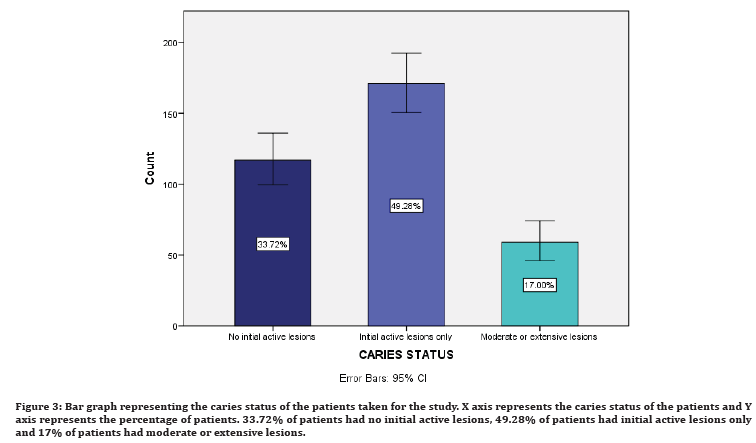
Figure 3: Bar graph representing the caries status of the patients taken for the study. X axis represents the caries status of the patients and Y axis represents the percentage of patients. 33.72% of patients had no initial active lesions, 49.28% of patients had initial active lesions only and 17% of patients had moderate or extensive lesions.
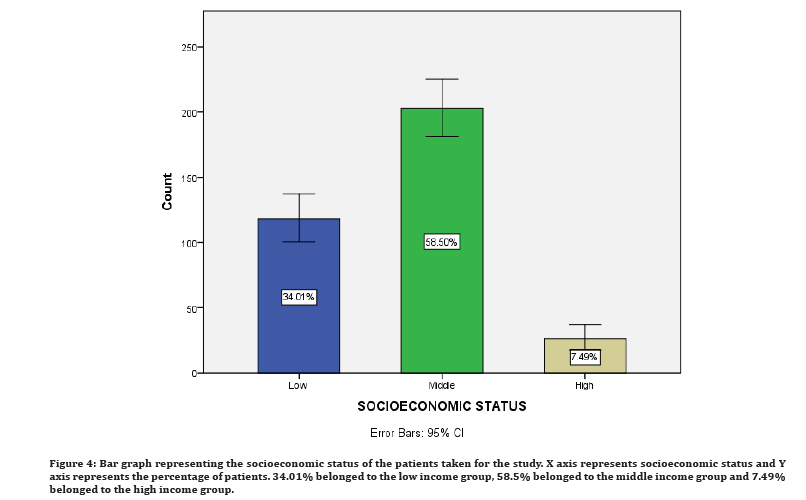
Figure 4: Bar graph representing the socioeconomic status of the patients taken for the study. X axis represents socioeconomic status and Y axis represents the percentage of patients. 34.01% belonged to the low income group, 58.5% belonged to the middle income group and 7.49% belonged to the high income group.
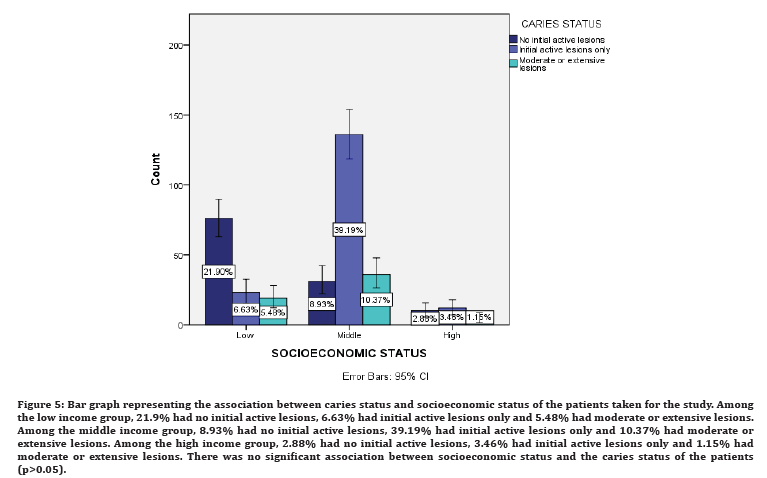
Figure 5: Bar graph representing the association between caries status and socioeconomic status of the patients taken for the study. Among the low income group, 21.9% had no initial active lesions, 6.63% had initial active lesions only and 5.48% had moderate or extensive lesions. Among the middle income group, 8.93% had no initial active lesions, 39.19% had initial active lesions only and 10.37% had moderate or extensive lesions. Among the high income group, 2.88% had no initial active lesions, 3.46% had initial active lesions only and 1.15% had moderate or extensive lesions. There was no significant association between socioeconomic status and the caries status of the patients (p>0.05).
Discussion
The elderly and the middle age population’s oral health status seems to decline because of social and economic inequalities. The severity of dental caries was significantly associated with the socioeconomic status markers of educational level, household income and type of household in this older population [29]. Our results showed that patients with a higher educational level and family income, and those from non-agricultural families, had less prevalence of Dental caries. Socioeconomic status is also considered to be a determinant in caries risk assessment. People belonging to the low socioeconomic group are more likely to present with pain, damaged teeth, unreplaced extracted teeth and other periodontal diseases [30].
Educational level of the patient affects the type of job and income, and thus access to preventive measures such as tooth cleaning habits, health service use and a lowcarbohydrate diet. Those with a high school background or above were less likely to have Decayed and Missing teeth [31]. Patients with any educational level higher than illiterate were more likely to seek professional help and to make better use of medical services and information. People with a lower educational level were more likely to have tooth extractions without receiving prosthesis. These findings indicate the need for programmes targeted at people with low educational levels to encourage them to receive appropriate treatment [32,33].
Educational qualification and the household income of people were significantly associated with the severity of Dental caries and other oral health-related issues and awareness. Monthly income of the individual mainly affects the number of filled teeth. Educational status, household income and socioeconomic status interact with each other in influencing dental caries [34]. The preventive strategies for Dental caries should focus on educating people about the consequences of oral diseases and on promoting oral health education, which particularly targets the population with low educational standards, household income and those from agricultural families [35]. Our study also shows that the government should provide economic assistance and medical insurance funds to cover oral diseases for populations with patients of low socioeconomic status. Furthermore, the research with a follow-up design is needed to confirm the causal relationship between socioeconomic status and dental caries and evaluate the effect of targeted intervention.
Limitations of the Study
This study is limited by a few factors. The sample size can be expanded and it is also a short duration study. Some of the patients may be left undiagnosed. The study also has geographical limitations since it is a hospital setting. However, various difficulties were faced when studying the dental caries status, which includes doctors or clinicians with variations in levels of knowledge, skill and experience, inconsistencies in judgments and research bias.
Future Scope of the Study
A large sample size of patients from different ethnicities would give better results for the study. Other epidemiological studies covering extended time periods would help in collecting important information and validate the findings further. The significance of correlation between socioeconomic status and dental caries during the clinical examination of the patient, especially for children and adolescents should be considered. Further studies on socioeconomic status and dental caries should have adequate sample size for an accurate determination of the association between socioeconomic status and dental caries status of the patients.
Conclusion
Within the limits of this study, we conclude that there was no significant association between the socioeconomic status and the caries status of the patients. Socioeconomic status plays a crucial role in explaining dental caries outcome. High educational level, high household income were protective against Dental caries. Prevention is the most cost-effective approach for reducing the prevalence of dental caries. Further research is required to confirm the correlation between socioeconomic status and dental caries and to evaluate the effect of targeted intervention.
Acknowledgement
The authors would like to acknowledge the help & support rendered by the Department of Aesthetic Dentistry, Saveetha Dental College and Hospitals, Saveetha Institute of Medical and Technical Sciences, Saveetha University for their constant assistance with the research.
Funding
The present project is sponsored by Saveetha Dental College and Hospitals, Saveetha Institute of Medical and Technical Sciences, Saveetha University and Ashok Leyland Private Limited, Chennai.
Conflict of Interest
None declared.
References
- Oliveira LB, Sheiham A, Bönecker M. Exploring the association of dental caries with social factors and nutritional status in Brazilian preschool children. Eur J Oral Sci 2008; 116:37–43.
- Langford M, Higgs G, Fry R. Multi-modal two-step floating catchment area analysis of primary health care accessibility. Health Place 2016; 38:70-81.
- Vehkalahti M, Nikula-Sarakorpi E, Paunio I. Evaluation of salivary tests and dental status in the prediction of caries increment in caries-susceptible teenagers. Caries Res 1996; 30:22–28.
- Poon PL. The association between socioeconomic status and dental caries in preschool children: A systematic review. HKU Theses Online (HKUTO) 2011.
- Madhusudhan KS, Khargekar N. Nutritional status and its relationship with dental caries among 3–6-year-old anganwadi children. Int J Clin Pediatr Dent 2020; 13:6.
- Mavridis N, Achimastos A. Secretor status and dental caries. J Dent Res 1974; 53:949.
- Mertz-Fairhurst EJ. Current status of sealant retention and caries prevention. J Dent Educ 1984; 48:18–26.
- Davis M. Association between dental caries and socioeconomic status among one to five-year-old native American children. 2014; 32.
- Muthukrishnan L. Imminent antimicrobial bioink deploying cellulose, alginate, EPS and synthetic polymers for 3D bioprinting of tissue constructs. Carbohydr Polym 2021; 260:117774.
- PradeepKumar AR, Shemesh H, Nivedhitha MS, et al. Diagnosis of vertical root fractures by cone-beam computed tomography in root-filled teeth with confirmation by direct visualization: A systematic review and meta-analysis. J Endod 2021; 47:1198–1214.
- Chakraborty T, Jamal RF, Battineni G, et al. A review of prolonged post-COVID-19 symptoms and their implications on dental management. Int J Environ Res Public Health 2021; 18.
- Muthukrishnan L. Nanotechnology for cleaner leather production: A review. Environ Chem Lett 2021; 19:2527–2549.
- Teja KV, Ramesh S. Is a filled lateral canal: A sign of superiority? J Dent Sci 2020; 15:562.
- Narendran K, Jayalakshmi, Ms N, et al. Synthesis, characterization, free radical scavenging and cytotoxic activities of phenylvilangin, a substituted dimer of embelin. J Pharm Sci 2020; 82.
- Reddy P, Krithikadatta J, Srinivasan V, et al. Dental caries profile and associated risk factors among adolescent school children in an urban south-Indian City. Oral Health Prev Dent 2020; 18:379–386.
- Sawant K, Pawar AM, Banga KS, et al. Dentinal microcracks after root canal instrumentation using instruments manufactured with different NiTi alloys and the SAF system: A systematic review. Adv Sci Inst Ser E Appl Sci 2021; 11:4984.
- Bhavikatti SK, Karobari MI, Zainuddin SLA, et al. Investigating the antioxidant and cytocompatibility of Mimusops elengi Linn extract over human gingival fibroblast cells. Int J Environ Res Public Health 2021; 18.
- Karobari MI, Basheer SN, Sayed FR, et al. An In Vitro stereomicroscopic evaluation of bioactivity between neo MTA Plus, Pro Root MTA, biodentine & glass ionomer cement using dye penetration method. Materials 2021; 14.
- Rohit Singh T, Ezhilarasan D. Ethanolic extract of Lagerstroemia speciosa (L.) Pers., Induces apoptosis and cell cycle arrest in HepG2 cells. Nutr Cancer 2020; 72:146–156.
- Ezhilarasan D. MicroRNA interplay between hepatic stellate cell quiescence and activation. Eur J Pharmacol 2020; 885:173507.
- Romera A, Peredpaya S, Shparyk Y, et al. Bevacizumab biosimilar BEVZ92 versus reference bevacizumab in combination with FOLFOX or FOLFIRI as first-line treatment for metastatic colorectal cancer: a multicentre, open-label, randomised controlled trial. Lancet Gastroenterol Hepatol 2018; 3:845–855.
- Raj RK. β‐Sitosterol‐assisted silver nanoparticles activates Nrf2 and triggers mitochondrial apoptosis via oxidative stress in human hepatocellular cancer cell line. J Biomed Material Res 2020; 108:1899-908.
- Vijayashree Priyadharsini J. In silico validation of the non-antibiotic drugs acetaminophen and ibuprofen as antibacterial agents against red complex pathogens. J Periodontol 2019; 90:1441–1448.
- Priyadharsini JV, Vijayashree Priyadharsini J, Smiline Girija AS, et al. In silico analysis of virulence genes in an emerging dental pathogen A. baumannii and related species. Arch Oral Biol 2018; 9493–98.
- Uma Maheswari TN, Nivedhitha MS, Ramani P. Expression profile of salivary micro RNA-21 and 31 in oral potentially malignant disorders. Braz Oral Res 2020; 34:e002.
- Gudipaneni RK, Alam MK, Patil SR, et al. Measurement of the maximum occlusal bite force and its relation to the caries spectrum of first permanent molars in early permanent dentition. J Clin Pediatr Dent 2020; 44:423–428.
- Chaturvedula BB, Muthukrishnan A, Bhuvaraghan A, et al. Dens invaginatus: A review and orthodontic implications. Br Dent J 2021; 230:345–350.
- Kanniah P, Radhamani J, Chelliah P, et al. Green synthesis of multifaceted silver nanoparticles using the flower extract of Aerva lanata and evaluation of its biological and environmental applications. Chem Select 2020; 5:2322–2331.
- https://www.proquest.com/openview/81094f9c8ce2fab7105923a895220293/1?pq-origsite=gscholar&cbl=18750&diss=y
- Poon PL. The association between socioeconomic status and dental caries in preschool children: A systematic review. 2017; Br Med J 2021; 11: e042908.
- Clifford H. Associations of dental caries status of queensland primary school children to health attitudes, behaviours and socio-economic factors: A correlational study within a randomised control trial tooth brushing at school. Queensland University of Technology 2006; 158.
- Christiono S, Putranto RR. Caries status early childhood caries in indonesian children with special needs: Study in SDLB central java. Dent J 2016; 2:1-7.
- Kidd E, Fejerskov O. How does a caries lesion develop? Essentials Dent Caries 2016.
- Siddiqui TM, Wali A. Socioeconomic status and dental caries: Exploring the relation in patients visiting dental teaching hospital, Karachi. JPDA 2019; 28:28.
- Punitha VC, Sivaprakasam P. Association of malnutrition and socioeconomic status in dental caries–A cross sectional study. J Oral Health Community Dent 2014; 8:12–15.
Indexed at, Google Scholar, Cross Ref
Indexed at, Google Scholar, Cross Ref
Indexed at, Google Scholar, Cross Ref
Indexed at, Google Scholar, Cross Ref
Indexed at, Google Scholar, Cross Ref
Indexed at, Google Scholar, Cross Ref
Indexed at, Google Scholar, Cross Ref
Indexed at, Google Scholar, Cross Ref
Indexed at, Google Scholar, Cross Ref
Indexed at, Google Scholar, Cross Ref
Indexed at, Google Scholar, Cross Ref
Indexed at, Google Scholar, Cross Ref
Indexed at, Google Scholar, Cross Ref
Indexed at, Google Scholar, Cross Ref
Indexed at, Google Scholar, Cross Ref
Indexed at, Google Scholar, Cross Ref
Indexed at, Google Scholar, Cross Ref
Indexed at, Google Scholar, Cross Ref
Indexed at, Google Scholar, Cross Ref
Indexed at, Google Scholar, Cross Ref
Indexed at, Google Scholar, Cross Ref
Indexed at, Google Scholar, Cross Ref
Indexed at, Google Scholar, Cross Ref
Indexed at, Google Scholar, Cross Ref
Indexed at, Google Scholar, Cross Ref
Author Info
Jagadheeswari Ramamoorthy and Mahalakshmi J*
Department of Conservative Dentistry and Endodontics, Saveetha Dental College and Hospitals, Saveetha Institute of Medical and Technical Sciences (SIMATS), Saveetha University, Chennai, Tamil Nadu, IndiaCitation: Jagadheeswari Ramamoorthy, Mahalakshmi J, Correlation of Socioeconomic Status and Dental Caries, J Res Med Dent Sci, 2022, 10 (6):161-167.
Received: 26-May-2022, Manuscript No. JRMDS-22-65014; , Pre QC No. JRMDS-22-65014 (PQ); Editor assigned: 28-May-2022, Pre QC No. JRMDS-22-65014 (PQ); Reviewed: 14-Jun-2022, QC No. JRMDS-22-65014; Revised: 17-Jun-2022, Manuscript No. JRMDS-22-65014 (R); Published: 24-Jun-2022
